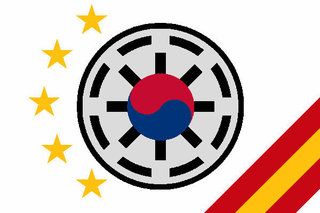.::Official Factbook::.

Flag of the Avatarian Republics

Seal of the Avatarian Republics
- I. General Overview
II. History
- 2.1 Discovery & Sozin’s Comet
2.2 The Great War
2.3 Unification
2.4 New Era
- 3.1 Basic Geography
3.2 Environment
3.3 Climate
- 4.1 Constitution
4.2 Structure
4.3 Foreign Relations
- 5.1 Overview
5.2 Holocron for the Military
- 6.1 People and Population
6.2 Languages
6.3 Religion
6.4 Holidays & Celebrations
6.5 Cuisine
6.6 Music
6.7 Sports
- 7.1 Government Officials
7.2 Military Personnel
7.3 Civilian Personnel
- 8.1 Domestic Statistics
8.2 Government Budget Details
8.3 Economic Details
X. Education
- 10.1 Overview
10.2 Primary School
10.3 Intermediate School
10.4 Secondary School
10.5 Post-secondary Education
10.6 Grading Scale
- 11.1 Facilities
11.2 Spending
11.3 Regulation
XIII. Technology
- 13.1 Overview
13.2 Communications
13.3 Transportation
Gyatso-kai, officially theAvatarian Republics of Gyatso-kai (Avatarian:凯海洋降世神通共和国; pinyin: Kǎihǎiyáng Jiàngshì Shéntōng Gònghéguó; Mandalorian: Tsad Droten be Gyats’kai), is a supranational federal republic occupying a large archipelago spanning six time zones in the northern Atlantian Oceania region. The founding nation of the former region of Avatar Incarnate and the once-prosperous Avatarian Union found throughout the world, Gyatso-kai now finds itself rebuilding within Atlantian Oceania. Given the vast size of the Avatarian Republics, its domain covers ??? square kilometers (???? sq mi) of land, spanning an archipelago of forty-three major islands grouped into six distinct island regions. With such a diverse collection of islands, the geography of the Avatarian Republics is just as diverse as the people who inhabit it.
The ancient Avatarian civilization --- one the world’s earliest --- flourished in the fertile basin of the Yellow River which, to this day, continues to flow through the Western Si Wong Valley. Gyatso-kai’s early political systems were based on hereditary monarchies known as dynasties from the time of the Xia (approximately 2000 BC). However, it was during the Yin Dynasty that the first unified Gyatso-kai would come to form in 1321 BC; granted, this unification would not last long with the growing cultural differences between the four main ethnic groups in the areas of Gyatso-kai at the time. It was in 1286 BC that the first of the Elemental Nations was formed: Under the tutelage of the Badgermoles, the people of the city now known as Omashu learned the Art of Earthbending, thus granting them innumerate powers over the other nations. In time, the other nations would be taught the Bending Arts by other species of animals whom deemed the elite status of the Earth Kingdoms to be a fault of the Badgermoles: The Fire Nation would learn Firebending in the Lost Temples of the Sun from the now-near-extinct Dragons, while the Water Tribes would learn Waterbending from the Spirits Tui and La and the Air Nomads would learn Airbending from the Sky Bisons.
Following centuries of great conflict between the various nations, the Great War erupted, plunging the lands of Gyatso-kai into a one-hundred-year-long war which would claim millions upon millions of lives and forever change the people of the Four Nations. It was under Avatar Roku in 1946.4 that The Great War would come to an end and the Unification of the Nations would occur in which the Four Elemental Nations would come together until a single banner and a single ruler --- The Avatar --- who would begin the seventy-year-long healing that The Great War had caused to the people of Gyatso-kai.
Since the Unification, Gyatso-kai has become the one of the region’s fastest growing major economy in terms of annual growth over the last six years. As such, Gyatso-kai maintains the 4th largest economy in its region: With an estimated GDP of US$ 835.9 trillion, Gyatso-kai holds itself proudly in the Top 10 for Atlantian Oceania's Highest Economic Output.


 or, when Aurebesh is not able to be used, ¥) (or simply minbi)
or, when Aurebesh is not able to be used, ¥) (or simply minbi)
